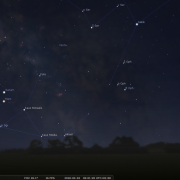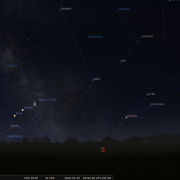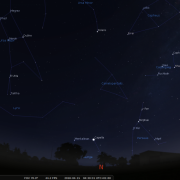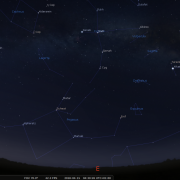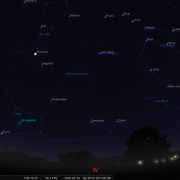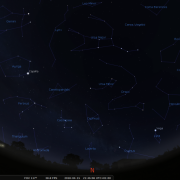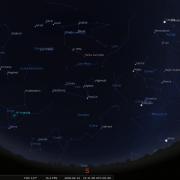Note for Diary: Monthly Meeting will be on Tuesday 17th April because of the College holiday timing.
Welcome to the WDAS monthly newsletter for April 2018: a digest of the month's latest contributions to our website. Below you'll find Society News, Sky Notes and another treat from the bakery, as well as coming events.
Society News
 Just to reminder that we shall be hosting a star party event for visiting pupils from Ayresome Primary School & Lego Innovation Studio up at the Whitby Youth Hostel on April 3rd 2018.
Just to reminder that we shall be hosting a star party event for visiting pupils from Ayresome Primary School & Lego Innovation Studio up at the Whitby Youth Hostel on April 3rd 2018.
Elizabeth Labelle, assistant Head Teacher, was greatly impressed with pupil feedback after last year’s event, and say’s the new party can’t wait to ‘do some star gazing’. The start time is around 20:30h at WHA on the east cliff.
The Star Party season on the West cliff will commence from May. Probable dates will be May 19th and 26th. The moon is visible, as well as several planets. Location will be the Captain Cook headland from 21:00h.
 After a 3 year break, all being well Paul will return to Whitby on May 8th to give a presentation on the Voyager probes to coincide with their 41st launch anniversary.
After a 3 year break, all being well Paul will return to Whitby on May 8th to give a presentation on the Voyager probes to coincide with their 41st launch anniversary.
Entitled “Triumphs of Voyager pt 1: Journey to Jupiter/Splendours of Saturn”, it promises to be every bit as informative and entertaining as Paul’s other talks.
The venue is the Main Hall at the Normanby campus of Whitby College (so that’s the big hall at Whitby School!) The venue offers ample parking, but is still within easy walking distance from the town.
We are planning on providing some kind of refreshments: sausage rolls, scones, tea and coffee etc. Admission is £3 (to be agreed). The doors will be open 19:00h for an intended 19:30h start. We would like to see as many members – past and present as possible, plus anyone who you think may be up for an evening of Paul Money enlightenment.
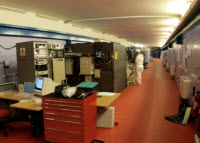 Following recent further correspondence with Dr Sean Paling regarding a visit to DMF at Boulby, it has been established that Friday’s are difficult for Sean and his team.
Following recent further correspondence with Dr Sean Paling regarding a visit to DMF at Boulby, it has been established that Friday’s are difficult for Sean and his team.
Therefore the original dates of May 11th and 18th are not viable. Tuesdays, Wednesday and Thursdays are best. So – bearing in mind it is a half-day afternoon visit – how about the 9th or 16th of May – We need to decide soon so that we can inform Sean. If another midweek date suits people better I need to know before our meeting on the 17th ideally.
Sky Notes
In this month's Sky Notes:
Planetary Skylights
 The month starts with Venus low in the western evening twilight, a conspicuous ‘evening star’. As we head through April Venus slowly gains in altitude, becoming ever more conspicuous to the naked eye.
The month starts with Venus low in the western evening twilight, a conspicuous ‘evening star’. As we head through April Venus slowly gains in altitude, becoming ever more conspicuous to the naked eye.
Look for it and a very slim crescent moon in earthshine on the 17th and 18th. During the latter part of April Venus tracks up between the descending Pleiades and Hyades star clusters in Taurus. Viewed through a telescope Venus exhibits a definite gibbous phase, but little else is evident beneath the duvet of cloud cover.

 As Venus sets in the west around 22:00h, so Jupiter rises in the east, a conspicuous presence second only in brightness to Venus. Although a late evening object, Jupiter is for the time being still best observed in the dawn sky, when at its highest to the south. The Moon lies nearby on the 2nd and 30th.
As Venus sets in the west around 22:00h, so Jupiter rises in the east, a conspicuous presence second only in brightness to Venus. Although a late evening object, Jupiter is for the time being still best observed in the dawn sky, when at its highest to the south. The Moon lies nearby on the 2nd and 30th.

 Throughout March Mars has been edging toward Saturn low in the dawn sky, and April commences with the pair pretty close together. View on the 3rd when pearly Saturn resides just above the ochre lustre of Mars. Then on the 7th and 8th a waning crescent moon lies in close proximity to both planets. Telescopically Mars still appears very small, with little detail discernible; this will change in the coming months. Saturn, on the other hand is a glorious spectacle, with the rings wide open, easily resolved in the smallest of instruments – binoculars aside.
Throughout March Mars has been edging toward Saturn low in the dawn sky, and April commences with the pair pretty close together. View on the 3rd when pearly Saturn resides just above the ochre lustre of Mars. Then on the 7th and 8th a waning crescent moon lies in close proximity to both planets. Telescopically Mars still appears very small, with little detail discernible; this will change in the coming months. Saturn, on the other hand is a glorious spectacle, with the rings wide open, easily resolved in the smallest of instruments – binoculars aside.
Meteors

The Lyrid meteor shower (April 16-25th) peaks in the early morning hours of April 22nd , fortunately after a waxing moon has set. The chances of spotting some shooting stars will therefore be quite favourable. The shower occurs as the Earth passes through the dust left over from Comet Thatcher (C/186 G1), which makes a full orbit of the sun once every 415 years.
The earliest sightings of the Lyrid meteor shower go back 2,700 years making it amongst the oldest of known meteor showers. Hourly rates exceed 25, however actual observed rates will be substantially lower than this, perhaps 12 or so. The radiant resides upper right of the bright star Vega in Lyra, so view in locations at least a couple of hands spans away from Lyra.
A number of lesser meteor showers occur during April. The Virginids and Alpha Scorpiids each have zenith hourly rates (ZHR) of around half a dozen, equating to ‘normal’ sporadic meteor activity levels. The Virginids peak on April 7/8th, during the early morning hours. The Scorpiids peak on the 27th but will be hampered by an almost full moon.
April 2018 Sky Charts
|
Looking North
Mid-April - 21:30h |
Looking South |
|
Looking East
Mid-April - 21:30h |
Looking West
Mid-April - 21:30h |
| Looking North (morning) Mid-April - 04:30h |
Looking South (morning) Mid-April - 04:30h |
| Looking East (morning) Mid-April - 04:30h |
Looking West (morning) Mid-April - 04:30h |
| Northern Aspect Mid-April - 21:45h |
Southern Aspect Mid-April - 21:30h |
Additional Image Credits:
- Planets and Comets where not otherwise mentioned: NASA
- Sky Charts: Stellarium Software
Continuing the tour of stellar objects crossing the meridian line this month: a double-star in the 'Sickle' of Leo, a field barred spiral galaxy also in Leo, knwon to its friends as "NGC 2903"; and the 'Ghost of Jupiter' planetary nebula in Hydra.
Star: Algieba in Leo ‘the Lion's Mane’
Telescope, Easy
One of the finest double stars in the spring sky and it could be argued in all the heavens – is gamma (γ) Leonis, proper name, Algieba, from the Arabic Al Jabbah (The Lion’s Mane).
Shining at mag +2.1 Algieba is comprised of magnitude 2.4 and 3.6 stars currently separated by 4.6 arc-seconds. They form a slowly widening binary system with an orbital period estimated at between 5 and 6 centuries.
Algieba is located in the “Sickle” of Leo - the brightest star after Regulus. The pair is just about resolved in small-aperture telescopes with medium power, certainly a decent 100mm scope at 80X magnification should split them, and once split Algieba is quite striking, both components being rich golden-yellow in hue indicative of its K0 and G7 spectra. Some observers note a slight greenish tinge to the companion.
At a distance of 131 light years, such giant pairings are rather unusual, Capella may be considered as a similar one. The orbital period is estimated to be around 510 years, the component stars separated on average by 170 Astronomical Units, more than four times the average distance of Pluto from the Sun. However due to the very high eccentricity, this could be anywhere between 26 and 313 AU apart. In 2010, astronomers announced the discovery of a giant planet orbiting the brighter giant, Gamma-1 (Gamma Leo A), with a minimum mass of 8.8 times that of Jupiter in an Earth-like orbit averaging 1.2 AU in size with a period of 1.2 years. Take your time when observing this stunning golden binary star system- it’s definitely worth it.
Crosses the 180 degree meridian line on various dates and times during April – try 11th at 22:00h. Telescope required to split components.

Star: Algieba in Leo, and location within Leo
Galaxy: NGC 2903
Telescope, Medium
This unique object was discovered by William Herschel on December 31, 1788. It lies at distance of almost 300,000 lightyears from the centre of our galaxy, making it one of the most distant known globular clusters, nearly twice the distance of the Large Magellanic Cloud.
American astronomer Harlow Shapley nicknamed it "The Intergalactic Tramp" believing it to have possibly broken away from the Milky Way, however, recent observations indicate Shapley hypothesis was incorrect and NGC 2419 is still gravitationally bound to the Milky Way, just moving in a highly eccentric orbit. At such a distance it's estimated it will take about 3 billion years to complete a single orbit around the centre of the galaxy. Although rather faint, NGC 2419 is probably one of the largest and intrinsically brightest known globulars, estimated to contain well over a million stars across a spatial diameter of 400 light-years, comparable in brightness to the spectacular Omega Centauri.
NGC 2419 is positioned 7 degrees north and slightly east of Castor (α Gem - mag. +1.58), About 4 arc minutes west of NGC 2419 is a mag. +7.2 star with a double star of mag. +7.9 a few more arc minutes further west. NGC 2419 shines at magnitude +10.3 and has an apparent diameter of 5 arc minutes. It's a somewhat challenging target especially under light polluted skies. In good sky conditions it can be spotted with a small 100mm (4-inch) aperture, but a 150 mm (6-inch) scope is required to clearly reveal it as a small fuzzy object that's clearly non-stellar. Scopes in excess of 18” are needed to resolve its brightest stars. It crosses the meridian on the 14th at 22:00h.
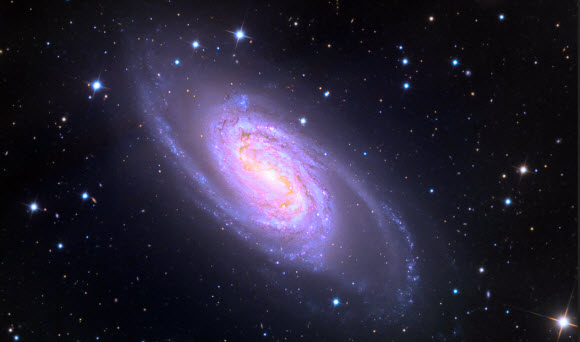
Globular Cluster: NGC 2903 (using 32" Schulman telescope on Mt Lemmon, Arizona, USA)
Nebula: NGC 3242 ‘Ghost of Jupiter’
100mm+ telescope: Medium
Discovered in 1785 by William Herchell below the belly of Hydra, this planetary nebula is often known as the Ghost of Jupiter due to its apparent similar angular size and hue to the planet when seen in the eyepiece. The “Ghost of Jupiter” really deserves at least as much attention as the more famous Ring Nebula in the constellation Lyra being at least 2 magnitudes brighter than the Ring at a relatively bright magnitude of 7.3.
The nebula measures around two light years and contains a central white dwarf with an apparent magnitude of 11. The inner layers of the nebula were formed some 1,500 years ago The two ends of the nebula are marked by lobes of fast moving gas often tinted red in false-colour pictures. NGC 3242 can easily be observed with amateur telescopes, and appears bluish-green to most observers. Larger telescopes can distinguish the outer halo as well. Look for it about 2 degrees southwest of the star μ (mu) Hydrae.
NGC 3242 crosses the meridian on the 13th at 22:00h (amongst other dates and times). Best viewed with at least 100mm aperture, medium power.

Nebula: NGC 3242 ‘Ghost of Jupiter’ planetary nebula (Click for larger image)


